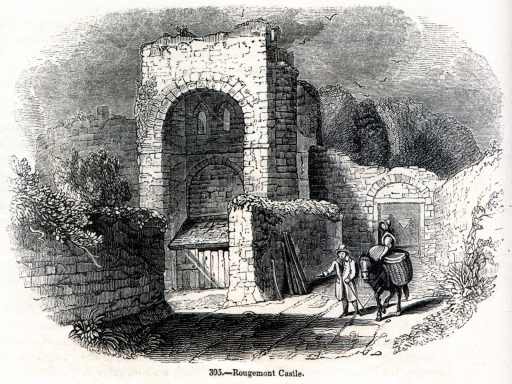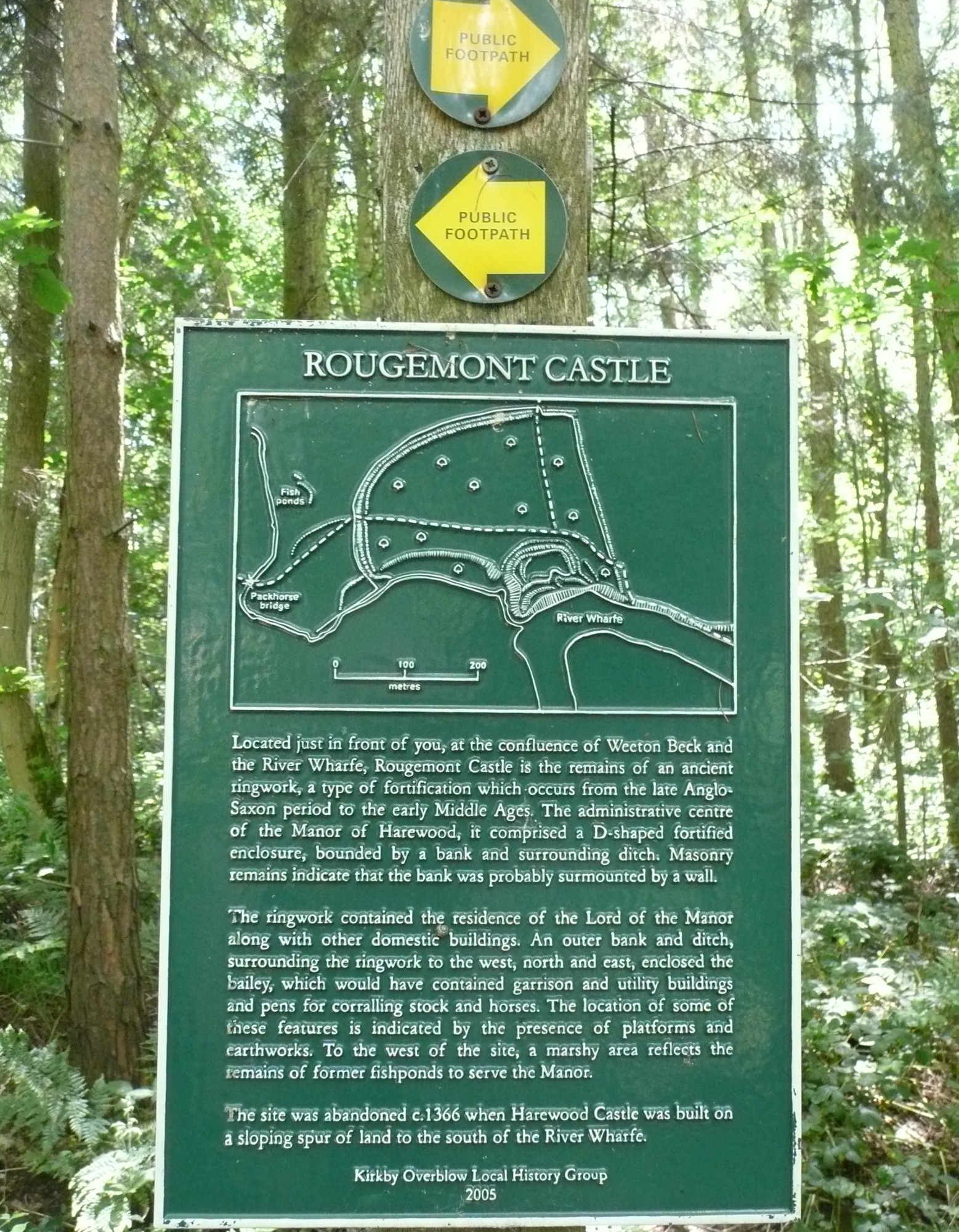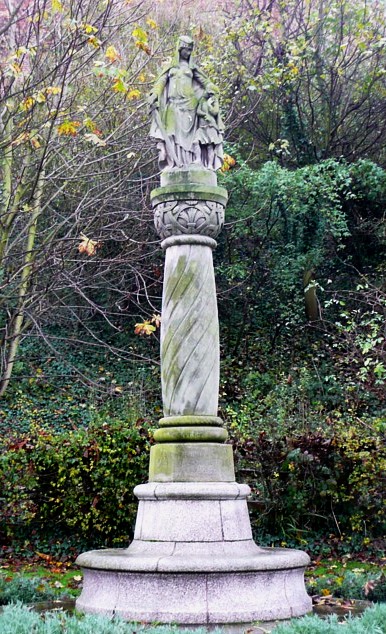|
Rougemont Castle
Rougemont Castle, also known as Exeter Castle, is the historic castle of the city of Exeter, Devon, England. It was built into the northern corner of the Roman city walls starting in or shortly after the year 1068, following Exeter's rebellion against William the Conqueror. In 1136 it was besieged for three months by King Stephen. An outer bailey, of which little now remains, was added later in the 12th century. The castle is mentioned in Shakespeare's play ''Richard III'' in a reference to that king's visit to Exeter in 1483. Devon's county court was located here from at least 1607, and the three Devon Witches—the last people in England to be executed for witchcraft—were tried and convicted at the Exeter Assizes in 1682. All the buildings inside the walls were swept away in the 1770s to make way for a new courthouse, which was extended by the addition of wings in 1895 and 1905. Because of its function as a court, the interior of the castle was not open to the public unti ... [...More Info...] [...Related Items...] OR: [Wikipedia] [Google] [Baidu] |
Rougemont Castle, Weeton
Rougemont Castle in the manor of Harewood, in the parish of Weeton, North Yorkshire, England, is a ruined ringwork castle, now largely hidden within over-grown woodland, located to the south east of the village of Weeton, above the north bank of the River Wharfe, where the river turns in a right-angle at its confluence with Weeton Beck. No above-ground structure survives but the earthwork features remain visible of building platforms, ditch system, outer enclosure and fish ponds. History It was the seat of the de Lisle family, of which Robert de Lisle was in 1311 created Baron Lisle "of Rougemont", to distinguish him from the unrelated family of Baron Lisle of Wootton, Isle of Wight in Hampshire, created in 1299. It served as the administrative centre of the manor of Harewood and as the residence of the lord of the manor. The site was abandoned in about 1366 when the Lisle family built Harewood Castle nearby, of which much of the ruined stone structure survives, also hidden i ... [...More Info...] [...Related Items...] OR: [Wikipedia] [Google] [Baidu] |
Æthelstan
Æthelstan or Athelstan (; ang, Æðelstān ; on, Aðalsteinn; ; – 27 October 939) was King of the Anglo-Saxons from 924 to 927 and King of the English from 927 to his death in 939. He was the son of King Edward the Elder and his first wife, Ecgwynn. Modern historians regard him as the first King of England and one of the "greatest Anglo-Saxon kings". He never married and had no children; he was succeeded by his half-brother, Edmund I. When Edward died in July 924, Æthelstan was accepted by the Mercians as king. His half-brother Ælfweard may have been recognised as king in Wessex, but died within three weeks of their father's death. Æthelstan encountered resistance in Wessex for several months, and was not crowned until September 925. In 927 he conquered the last remaining Viking kingdom, York, making him the first Anglo-Saxon ruler of the whole of England. In 934 he invaded Scotland and forced Constantine II to submit to him. Æthelstan's rule was resented by the S ... [...More Info...] [...Related Items...] OR: [Wikipedia] [Google] [Baidu] |
Outwork
An outwork is a minor fortification built or established outside the principal fortification limits, detached or semidetached. Outworks such as ravelins, lunettes (demilunes), flèches and caponiers to shield bastions and fortification curtains from direct battery were developed in the 16th century. Later, the increasing scale of warfare and the greater resources available to the besieger accelerated this development, and systems of outworks grew increasingly elaborate and sprawling as a means of slowing the attacker's progress and making it more costly. When taken by an enemy force, their lack of rear-facing ramparts left them totally open to fire from the main works. [...More Info...] [...Related Items...] OR: [Wikipedia] [Google] [Baidu] |
Barbican
A barbican (from fro, barbacane) is a fortified outpost or fortified gateway, such as at an outer fortifications, defense perimeter of a city or castle, or any tower situated over a gate or bridge which was used for defensive purposes. Europe In the Middle Ages, barbicans were typically situated outside the main line of defenses, and were connected to the Defensive wall, city walls with a walled road called ''the neck''. In the 15th century, with the improvement in siege tactics and artillery, barbicans lost their significance. Barbicans were built well into the 16th century. Fortified or mock-fortified gatehouses remained a feature of ambitious French and English residences well into the 17th century. Portuguese medieval fortification nomenclature uses barbican to describe any wall outside of and lower than the main defensive wall that forms a second barrier. The barrier may be complete, extensive or only protect particularly weak areas. The more restrictive term ''gate barb ... [...More Info...] [...Related Items...] OR: [Wikipedia] [Google] [Baidu] |
Baldwin De Redvers, 1st Earl Of Devon
Baldwin de Redvers, 1st Earl of Devon (died 4 June 1155), feudal baron of Plympton in Devon, was the son of Richard de Redvers and his wife Adeline Peverel. He was one of the first to rebel against King Stephen, and was the only first rank magnate never to accept the new king. He seized Exeter, and was a pirate out of Carisbrooke, but he was driven out of England to Anjou, where he joined the Empress Matilda. She made him Earl of Devon after she established herself in England, probably in early 1141. He founded several monasteries, notably those of Quarr Abbey (1131), in the Isle of Wight, a priory at Breamore, Hampshire, and the Priory of St James, at Exeter. Some monastic chronicles call his father also Earl of Devon, but no contemporary record uses the title, including the monastic charters. Family and children He married Adelize De Baalun (d. circa 1146).Bearman, R. (1994).''Charters of The Redvers Family and the Earldom of Devon 1090–1217''. p. 9. They had childre ... [...More Info...] [...Related Items...] OR: [Wikipedia] [Google] [Baidu] |
Exwick
Exwick is an historic parish and manor in Devon, England, which today is a north-western suburb of the City of Exeter. Its name is derived from the River Exe, which forms its eastern boundary. It is also an Ecclesiastical parish and an electoral ward. Mentioned in the Domesday Book, it was the site of farms, orchards and mills. Exwick meaning farm by the river Exe. Being on the edge of the Exe floodplain, mill industries were important in Exwick. A leat from the Exe was dug before the Doomsday book was compiled. Other industries formerly in the area include clothmaking, aeroparts and baking. Manufacture of wooden flooring continues to this day. There were a number of large houses in the area including Cleve House which became a Guide Dogs for the Blind training centre in the 1950s. Later it became private houses and the site of a new primary school. The Mallet family bought Exwick Mill. Another important family with an Exwick Connection were the Gibbs. Andrew Gibbs from C ... [...More Info...] [...Related Items...] OR: [Wikipedia] [Google] [Baidu] |
Prebendary
A prebendary is a member of the Roman Catholic or Anglican clergy, a form of canon with a role in the administration of a cathedral or collegiate church. When attending services, prebendaries sit in particular seats, usually at the back of the choir stalls, known as prebendal stalls. History At the time of the ''Domesday Book'' in 1086, the canons and dignitaries of the cathedrals of England were supported by the produce and other profits from the cathedral estates.. In the early 12th century, the endowed prebend was developed as an institution, in possession of which a cathedral official had a fixed and independent income. This made the cathedral canons independent of the bishop, and created posts that attracted the younger sons of the nobility. Part of the endowment was retained in a common fund, known in Latin as ''communia'', which was used to provide bread and money to a canon in residence in addition to the income from his prebend. Most prebends disappeared in 1547, ... [...More Info...] [...Related Items...] OR: [Wikipedia] [Google] [Baidu] |
Orderic Vitalis
Orderic Vitalis ( la, Ordericus Vitalis; 16 February 1075 – ) was an English chronicler and Benedictine monk who wrote one of the great contemporary chronicles of 11th- and 12th-century Normandy and Anglo-Norman England. Modern historians view him as a reliable source. Background Orderic was born on 16 February 1075 in Atcham, Shropshire, England, the eldest son of a French priest, Odelerius of Orléans, who had entered the service of Roger de Montgomery, 1st Earl of Shrewsbury, and had received from his patron a chapel there. By the late 11th century, clerical marriage was still not uncommon in western Christendom. Orderic was one of the few monks who were of mixed parentage as his mother was of English heritage. When Orderic was five, his parents sent him to an English monk, Siward by name, who kept a school in the Abbey of SS Peter and Paul at Shrewsbury. At the age of ten, Orderic was entrusted as an oblate to the Abbey of Saint-Evroul in the Duchy of Normandy, wh ... [...More Info...] [...Related Items...] OR: [Wikipedia] [Google] [Baidu] |
Curtain Wall (fortification)
A curtain wall is a defensive wall between two fortified towers or bastions of a castle, fortress, or town. Ancient fortifications Evidence for curtain walls or a series of walls surrounding a town or fortress can be found in the historical sources from Assyria and Egypt. Some notable examples are ancient Tel Lachish in Israel and Buhen in Egypt. Curtain walls were built across Europe during the Roman Empire; the early 5th century Theodosian Walls of Constantinople influenced the builders of medieval castles many centuries later. Curtain wall castles In medieval castles, the area surrounded by a curtain wall, with or without towers, is known as the bailey. The outermost walls with their integrated bastions and wall towers together make up the enceinte or main defensive line enclosing the site. In medieval designs of castle and town, the curtain walls were often built to a considerable height and were fronted by a ditch or moat to make assault difficult. Walls were toppe ... [...More Info...] [...Related Items...] OR: [Wikipedia] [Google] [Baidu] |
Stockade
A stockade is an enclosure of palisades and tall walls, made of logs placed side by side vertically, with the tops sharpened as a defensive wall. Etymology ''Stockade'' is derived from the French word ''estocade''. The French word was derived from the Spanish word ''estacada''. As a frontier outpost It was used as an outpost because it provided cover and was safe to look at things through. As a security fence The troops or settlers would build a stockade by clearing a space of woodland and using the trees whole or chopped in half, with one end sharpened on each. They would dig a narrow trench around the area, and stand the sharpened logs side-by-side inside it, encircling the perimeter. Sometimes they would add additional defence by placing sharpened sticks in a shallow secondary trench outside the stockade. In colder climates sometimes the stockade received a coating of clay or mud that would make the crude wall wind-proof. Builders could also place stones or thick mud la ... [...More Info...] [...Related Items...] OR: [Wikipedia] [Google] [Baidu] |
Quoin
Quoins ( or ) are masonry blocks at the corner of a wall. Some are structural, providing strength for a wall made with inferior stone or rubble, while others merely add aesthetic detail to a corner. According to one 19th century encyclopedia, these imply strength, permanence, and expense, all reinforcing the onlooker's sense of a structure's presence. Stone quoins are used on stone or brick buildings. Brick quoins may appear on brick buildings, extending from the facing brickwork in such a way as to give the appearance of generally uniformly cut ashlar blocks of stone larger than the bricks. Where quoins are decorative and non-load-bearing a wider variety of materials is used, including timber, stucco, or other cement render. Techniques Ashlar blocks In a traditional, often decorative use, large rectangular ashlar stone blocks or replicas are laid horizontally at the corners. This results in an alternate, quoining pattern. Alternate cornerstones Courses of large and small c ... [...More Info...] [...Related Items...] OR: [Wikipedia] [Google] [Baidu] |
Anglo-Saxon Architecture
Anglo-Saxon architecture was a period in the history of architecture in England from the mid-5th century until the Norman Conquest of 1066. Anglo-Saxon secular buildings in Britain were generally simple, constructed mainly using timber with thatch for roofing. No universally accepted example survives above ground. Generally preferring not to settle within the old Roman cities, the Anglo-Saxons built small towns near their centres of agriculture, at fords in rivers or sited to serve as ports. In each town, a main hall was in the centre, provided with a central hearth. There are many remains of Anglo-Saxon church architecture. At least fifty churches are of Anglo-Saxon origin with major Anglo-Saxon architectural features, with many more claiming to be, although in some cases the Anglo-Saxon part is small and much-altered. It is often impossible to reliably distinguish between pre- and post-Conquest 11th century work in buildings where most parts are later additions or alterations. ... [...More Info...] [...Related Items...] OR: [Wikipedia] [Google] [Baidu] |







